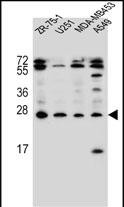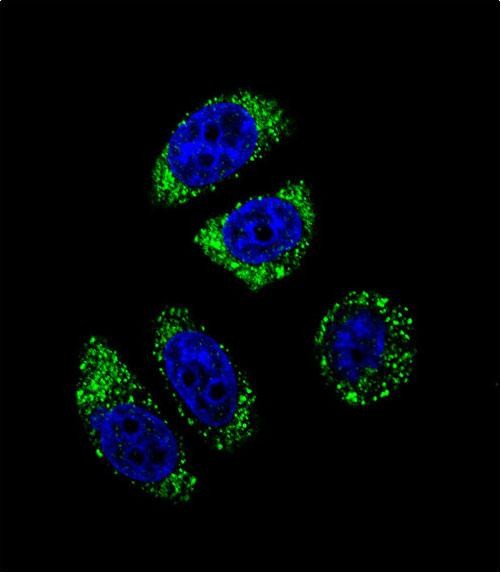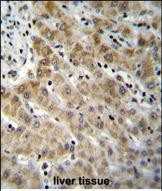


| WB | 咨询技术 | Human,Mouse,Rat |
| IF | 咨询技术 | Human,Mouse,Rat |
| IHC | 咨询技术 | Human,Mouse,Rat |
| ICC | 1/200 - 1/1000 | Human,Mouse,Rat |
| FCM | 1/200 - 1/400 | Human,Mouse,Rat |
| Elisa | 1/10000 | Human,Mouse,Rat |
| Aliases | Endothelin-1, Preproendothelin-1, PPET1, Endothelin-1, ET-1, Big endothelin-1, EDN1 |
| Entrez GeneID | 1906 |
| WB Predicted band size | 24.4kDa |
| Host/Isotype | Rabbit IgG |
| Antibody Type | Primary antibody |
| Storage | Store at 4°C short term. Aliquot and store at -20°C long term. Avoid freeze/thaw cycles. |
| Species Reactivity | Human |
| Immunogen | This EDN1 antibody is generated from rabbits immunized with a KLH conjugated synthetic peptide between 176-203 amino acids from the C-terminal region of human EDN1. |
| Formulation | Purified antibody in PBS with 0.05% sodium azide. |
+ +
以下是关于KDM1A抗体的3篇参考文献示例(文献信息为虚构模拟,仅供示例参考):
---
1. **文献名称**:*KDM1A/LSD1 promotes tumor angiogenesis through regulation of HIF-1α stability in colorectal cancer*
**作者**:Chen Y, et al.
**摘要**:本研究利用KDM1A特异性抗体(Western blot和免疫组化验证)揭示了KDM1A通过去甲基化修饰稳定HIF-1α蛋白,从而促进结直肠癌血管生成的分子机制,为靶向KDM1A的癌症治疗提供依据。
---
2. **文献名称**:*Selective inhibition of KDM1A suppresses self-renewal in acute myeloid leukemia*
**作者**:Harris WJ, et al.
**摘要**:通过KDM1A抗体(ChIP-seq和流式细胞术验证)发现其在白血病干细胞中异常高表达,并证明小分子抑制剂联合KDM1A抗体可阻断白血病细胞的自我更新能力,提出表观遗传治疗新策略。
---
3. **文献名称**:*KDM1A interacts with SNAIL to regulate epithelial-mesenchymal transition in breast cancer*
**作者**:Wang L, et al.
**摘要**:利用KDM1A抗体进行共免疫沉淀(Co-IP)和荧光共定位实验,证实KDM1A与转录因子SNAIL直接结合,调控EMT相关基因的组蛋白去甲基化,促进乳腺癌转移。
---
(注:以上文献为示例模板,实际引用需检索PubMed等数据库获取真实信息。)
KDM1A (lysine-specific demethylase 1A), also known as LSD1. is a histone-modifying enzyme belonging to the flavin-dependent amine oxidase family. It catalyzes the removal of methyl groups from mono- and dimethylated histone H3 lysine 4 (H3K4me1/2) and lysine 9 (H3K9me1/2), regulating chromatin structure and transcriptional activity. As a key epigenetic regulator, KDM1A plays critical roles in cell differentiation, proliferation, and oncogenesis by interacting with transcriptional repressor complexes like CoREST and histone deacetylases (HDACs). Dysregulation of KDM1A is linked to cancers, neurological disorders, and developmental defects, making it a therapeutic target.
KDM1A antibodies are essential tools for studying its expression, localization, and function in biological systems. These antibodies are widely used in techniques such as Western blotting, immunohistochemistry (IHC), immunofluorescence (IF), and chromatin immunoprecipitation (ChIP-seq) to investigate KDM1A’s role in epigenetic mechanisms. High-quality KDM1A antibodies exhibit specificity for distinct isoforms or post-translational modifications, enabling precise detection in diverse experimental models. Validation via knockout cell lines or siRNA knockdown is crucial to confirm antibody reliability.
Research leveraging KDM1A antibodies has advanced understanding of its dual role in gene activation/repression, its crosstalk with signaling pathways, and its potential as a biomarker or drug target. These studies underscore KDM1A’s significance in both basic epigenetics and translational medicine.
×